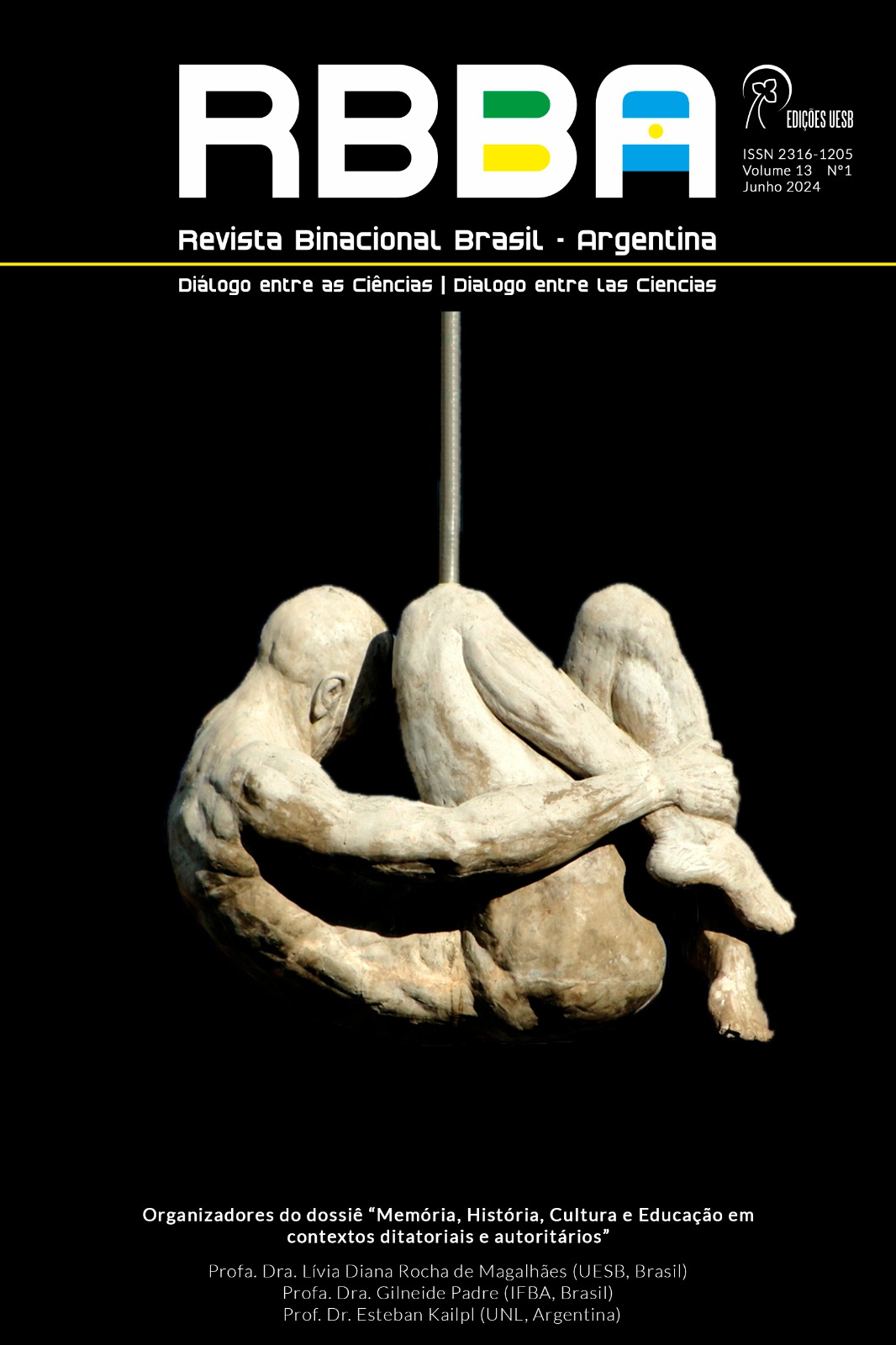Conceptual vignettes for teaching didactics of Mathematics
DOI:
https://doi.org/10.22481/rbba.v13i01.14230Keywords:
Concept cartoons, Teaching of didactics, Research results, Teacher trainingAbstract
We explored the potential of a sequence of conceptual vignettes for the teaching and learning of research findings related to understanding the equals sign in algebraic entry. We designed a sequence of three conceptual vignettes based on empirical evidence adapted for teaching research findings. In their fourth and final year of a teaching program at a teacher training institute in Uruguay, a class group comprising five students specialising in mathematics education participated. We implemented the sequence of conceptual vignettes in a 120-minute working session with the entire group. The participants demonstrated progress in understanding that specific interpretations of the equals sign can interfere with learning algebra. The sequence of conceptual vignettes facilitated the understanding of research findings regarding the comprehension of the equals sign in algebraic entry. Further studies are required to delve deeper into this line of research.
Downloads
References
BALL, D., THAMES, M.; PHELPS, G. Content knowledge for teaching: what makes it special? Journal of Teacher Education, v. 59, n. 5, p. 389–407, nov. 2008.
BROUSSEAU, G. Iniciación al estudio de la teoría de las situaciones didácticas. Buenos Aires: Libros del Zorzal, 2007.
BUCHBINDER, O.; KUNTZE, S. Mathematics teachers engaging with representations of practice. Berlín: Springer, 2018.
BURGELL, F.; OCHOVIET, C. Significados del signo de igual y aspectos de su enseñanza. Un estudio realizado con estudiantes de primer año de enseñanza secundaria y sus profesores. Enseñanza de las Ciencias, v. 33, n. 3, p. 77–98, 2015.
DOLYENKO, I.; GONZÁLEZ, D.; GONZÁLEZ, L.; OCHOVIET, C. Viñetas conceptuales para aprender matemática. Montevideo: Imaginar ediciones, 2020.
FERNÁNDEZ, J.; MOLFINO, V.; OCHOVIET, C. Rol docente del investigador en matemática educativa: un ejemplo en un curso de posgrado para profesores del nivel superior. Bolema, n. 30, p. 808–829, 2016.
FRIESEN, M.; KNOX, A. Pre-service teachers learn to analyse students' problem-solving strategies with cartoon vignettes. En: CONGRESO DE LA SOCIEDAD EUROPEA DE INVESTIGACIÓN EN EDUCACIÓN MATEMÁTICA, 12, 2022, Bozen-Bolzano. Actas... Bozen-Bolzano: HAL, 2022.
IVARS, P., BUFORN, A.; LLINARES, S. Diseño de tareas y desarrollo de una mirada profesional sobre la enseñanza de las matemáticas de estudiantes para maestro. En: SALCEDO, A. (Ed.), Alternativas Pedagógicas para la Educación Matemática del Siglo XXI. Caracas: CIES, 2017. p. 65–88.
JACOBS, V., LAMB, L.; PHILIPP, R. Professional noticing of children's mathematical thinking. Journal for Research in Mathematics Education, v. 41, n. 2, p. 169–202, mar. 2010.
KEOGH, B.; DABELL, J.; NAYLOR, S. Concept cartoons in mathematics education. Millgate House Publishers, 2008.
KIERAN, C. Concepts associated with the equality symbol. Educational Studies in Mathematics, v. 12, n. 3, p. 317–326, ago. 1981.
KNUTH, E., ALIBALI, M., HATTIKUNDUR, S., MCNEIL, N.; STEPHENS, A. The importance of equal sign understanding in the middle grades. Mathematics Teaching in the Middle School, v. 13, n. 9, p. 514–519, may. 2008.
KUNTZE, S. et al. “Helping learners” – Pre-service mathematics teachers’ conceptions of learning support through the lens of their situated noticing – A vignette-based study. En: CONFERENCIA DEL GRUPO INTERNACIONAL DE PSICOLOGÍA DE EDUCACIÓN MATEMÁTICA, 45, 2022, Alicante. Actas... Alicante: PME, 2022. p. 91–98.
MOLFINO, V.; OCHOVIET, C. La producción de conocimiento didáctico en la formación de profesores de matemática: la investigación como herramienta. En: Macedo, B.; Silveira, S.; Meziat, D.; García, M.; Bengochea, L. (Eds.), Enseñanza y Aprendizaje de las Ciencias en Debate. Montevideo: Universidad de Alcalá–Consejo de Formación en Educación, 2019. p. 616–625.
NAYLOR, S.; KEOGH, B. Concept cartoons: what have we learnt? Journal of Turkish Science Education, v. 10, n. 1, p. 3–11, mar. 2013.
OCHOVIET, C.; OKTAC, A. Comprender los resultados de investigación: el rol docente del investigador en la enseñanza de la matemática educativa. Reflexión e Investigación en Matemática Educativa, p. 53–80, 2011.
PARODI, S. Significados del signo igual en la entrada al álgebra. 2016. 303 f. Tesis (Maestría en Ciencias en Matemática Educativa), IPN, México.
PARODI, S. (2021). La habilidad de mirar profesionalmente del futuro profesor en situaciones que involucran al signo igual. 2021. 304 f. Tesis (Doctorado en Matemática Educativa), IPN, México.
PARODI, S.; OCHOVIET, C.; LEZAMA, J. La comprensión del signo de igual en la entrada al álgebra: el diseño de tareas y la conversación en la clase de matemática. Enseñanza de las Ciencias, v. 35, n. 3, p. 51–67, 2017.
PARODI, S.; OCHOVIET, C.; LEZAMA, J. Interpretaciones del signo igual en un contexto algebraico de polinomios. Bolema, n. 34, p. 1264–1284, 2020.
PREDIGER, S. How to develop mathematics–for–teaching and for understanding: the case of meanings of the equal sign. Journal of Mathematics Teacher Education, v. 13, n. 1, p. 73–93, ago. 2010.
ROWLAND, T., TURNER, F.; THWAITES, A. Research into teacher knowledge: a stimulus for development in mathematics teacher education practice. ZDM, n. 46, p. 317–328, dic. 2014
SAMKOVÁ, L. Using Concept Cartoons to investigate future teachers' knowledge: new findings and results. En: CONFERENCIA TEMÁTICA SOBRE ENSEÑANZA MATEMÁTICA, RECURSOS Y DESARROLLO PROFESIONAL DOCENTE, 3, 2016, Berlín. Actas... Berlín: Humboldt Universität–HAL Archive, 2016. p. 207–216.
SAMKOVÁ, L. Assessing future teachers' knowledge on fractions: written tests vs concept cartoons. Journal on Efficiency and Responsibility in Education and Science, v. 11, n. 3, p. 45–52, oct. 2018.
SAMKOVÁ, L.; HOSPESOVÁ, A. Using concept cartoons to investigate future teachers' knowledge. En: CONGRESO DE LA SOCIEDAD EUROPEA DE INVESTIGACIÓN EN EDUCACIÓN MATEMÁTICA, 9, 2015, Praga. Actas... Praga: Charles University, 2015. p. 3241–3247.
STEPHENS, A. Equivalence and relational thinking: preservice elementary teachers' awareness of opportunities and misconceptions. Journal of Mathematics Teacher Education, v. 9, n. 3, p. 249–278, abr. 2006.
VINNER, S. Inconsistencies: their causes and function in learning mathematics. Focus on Learning Problems in Mathematics, v. 12, n. 3, p. 85–98, 1990.
Downloads
Published
How to Cite
Issue
Section
License
Copyright (c) 2024 Revista Binacional Brasil-Argentina: Dialogue between the sciences

This work is licensed under a Creative Commons Attribution 4.0 International License.






